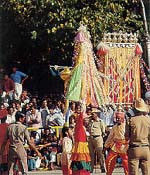
Dussera - Day of Victory

Dussera - Day of Victory
Vijayadashami or Dussera, the tenth day of the bright half of Aswin is celebrated as the day of victory to rejoice about Durga's triumph over the demon Mahishasura. In Mysore in the hilltop Chamundi temple, Dussera is a picturesque festival. The goddess is the Maharaja's family deity and a procession of elephants, courtiers and court symbols attracts tourists by the thousands as it wends its circuitous way to the temple, decorated splendidly for the festival. With the decline of the royal family of Mysore however the festival has lost some its traditional luster.
In Tamil Nadu, Andhra Pradesh and Karnataka, families arrange dolls(Bommai Kolu) and artifacts with decorative displays of lamps and flower. Women traditionally exchange gifts of coconuts, clothes and sweets.
In the northern states Dussera also celebrates the homecoming of Rama the hero of the epic Ramayana, after his victory over Ravana, the king of Lanka. In vast open spaces, Ramleela, the folk play with music and spontaneous dialogues, retelling the story of the life of Rama, are enacted till the wee hours. Songs are sung in praise of Rama and people in thousands witness this traditional theatre with its exaggerated costumes, jewellery, makeup and drama. Larger than life figures of Ravana and other demons are burnt on cold dark nights with fireworks lighting up the sky.

Dussera is also reminiscent of the end of the exile and banishment of the Pandava princes in the Mahabharata and their return with their weapons to reclaim their kingdom. In memory of this epic story, people in Maharashtra worship the implements of their professions and distribute the leaves of the Shami tree as gold and express their goodwill.
Vijayadashami is the day of the Saraswati or the deity of knowledge and learning. Children begin their school education, their art lessons or their career planning on this day and seek their elders blessings. For Hindus Dussera is one of the four most auspicious days of the year.
(Source : Celebrations - Festivals of India by Vimla Patil)